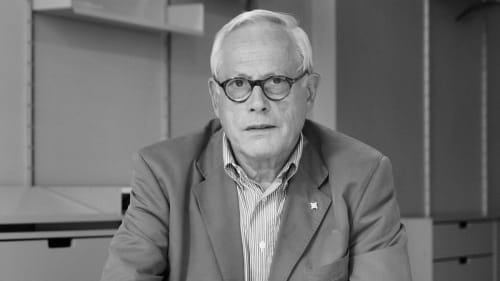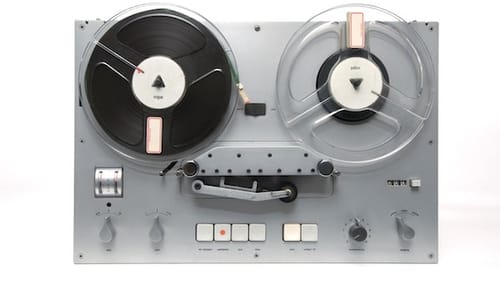Stay in the Loop
BSR publishes on a weekly schedule, with an email newsletter every Wednesday and Thursday morning. There’s no paywall, and subscribing is always free.
Design so good, you might not notice
Philadelphia Museum of Art presents Dieter Rams: Principled Design

You know Dieter Rams, even if you’ve never heard his name. The German designer, a recent recipient of the Philadelphia Museum of Art’s (PMA) Collab Design Excellence Award, is the subject of the museum’s Dieter Rams: Principled Design.
If you’re a child of the 20th century, you likely grew up seeing objects he designed in kitchens and living rooms. A child of the millennium? You’re probably holding a device inspired by Rams’s aesthetic.
Architect of the Braun brand
Rams, now 86, is most identified with Braun AG, purveyor of consumer goods including countertop appliances, timepieces, personal-grooming tools, and equipment to receive, play, and record music. Rams joined the firm in 1955 and, as design director, became principal architect of the understated, streamlined style for which Braun became known.
Whether designing a coffee maker or a movie camera, Rams’s first thought was always of the consumer. “His exquisite attention to detail, genius for interface reduction, and almost poetic sense of harmony and balance… is entirely directed towards the comfort of the user, to improving their lives in small but important ways,” wrote Sophie Lovell in her book Dieter Rams: As Little Design as Possible.
Rams unified Braun’s corporate style and products. He limited the color palette, materials, and controls. Colors are uniformly subdued, as in Braun’s ET 66 Control Electronic Calculator (1987).
Designed by Rams and Dietrich Lubs, the calculator is entirely black except for two bright buttons: red for “off” and yellow for “equals.” The then-revolutionary tool incorporates other user-friendly features, such as ridged edges that make it easier to hold and easy-to-press convex circular buttons.
Honest, innovative, understandable objects
Though understatement is a hallmark of his visual style, Rams doesn’t believe in disguises. Typically, early home-entertainment equipment was encased in wood to make it look more like furniture and, ostensibly, less intimidating.
Rams brought stereos and televisions out of hiding, but endowed them with quiet personalities through muted colors, rounded edges, and controls that were simple for consumers to find and understand. “They are neither decorative objects nor works of art,” Rams once said. “Their design should, therefore, be neutral and restrained, to leave room for the user’s self-expression.”

Besides creating honest, understandable, and useful objects, Rams and his design team collaborated closely with engineers to incorporate the latest innovations — a neverending challenge in rapidly advancing media. Consumers who grew up sitting in front of giant stationary radios saw their offspring carry transistor receivers — a cycle their grandchildren would repeat with telephones and computers.
The implements Rams designed or supervised are visually calming, no matter how complex their function. Multipart systems, whether for stereos or shelving, are flexible. Consumers decide which components they need and configure them accordingly.
The Atelier system, which was designed by Peter Hartwein and Rams in the 1980s and became a flagship product line for Braun, is an example. It enabled consumers to stack state-of-the-art components such as record players, cassette recorders, tuners, and amplifiers into neat black cubes.
Defining good design
Rams’s influence is obvious in one exhibit: a pair of portable radios. Braun’s Exporter I (1954) and Exporter II (1956) are fraternal twins. They share the size and shape of a large paperback, and their features (handle, control, speaker, logo) are in exactly the same location, but they look nothing alike.
Exporter I is Marlon Brando to the Exporter II’s Paul Newman. The pre-Rams model is edgy and brooding, dark in tones of maroon and gold, while the Rams model is refined and cool, in white and gray.

Rams crystallized his design sensibility into 10 principles in 1985. “Products we use every day affect our person and our well-being,” he said. “But only well-executed products can be beautiful.”
Design, he believes, should incorporate new technology and make useful things. It should be honest: simple and thorough, leading to products that recede into the background until needed, then perform optimally.
Well-designed objects should last and be environmentally friendly. “The time of thoughtless design for thoughtless consumption is over,” he comments in Gary Hustwit’s 2018 documentary Rams, a segment of which runs in the Collab gallery.
Design DNA
When he was growing up in London, long before he knew anything about Rams, Jonathan Ive admired the Braun MPZ 2 Citromatic juicer in his kitchen. “At a glance, you knew exactly what it was and exactly how to use it… I was completely enchanted,” he wrote in the foreword to Lovell’s book.
Ive went on to become Apple’s chief design officer. In the gallery, a 2001 iPod he created with Apple’s industrial-design team sits just below a 1958 transistor radio by Rams and HfG Ulm. The lineage is undeniable.
With limited gallery text and ample examples of Rams’s work for Braun and Vitsoe, the furniture firm he cofounded in 1959, curator Colin Fanning allows the viewer to experience the deceptive simplicity of Rams’s esthetic viscerally.
It makes one long to replicate the feeling at home, perhaps by outfitting a kitchen with only his tools. This might not make meals taste any better, but the chef would surely be more serene.
What, When, Where
Dieter Rams: Principled Design. Through April 14, 2019, at the Philadelphia Museum of Art, Ruth and Raymond G. Perelman Building, 2525 Pennsylvania Avenue, Philadelphia. (215) 763-8100 or philamuseum.org.
Sign up for our newsletter
All of the week's new articles, all in one place. Sign up for the free weekly BSR newsletters, and don't miss a conversation.
